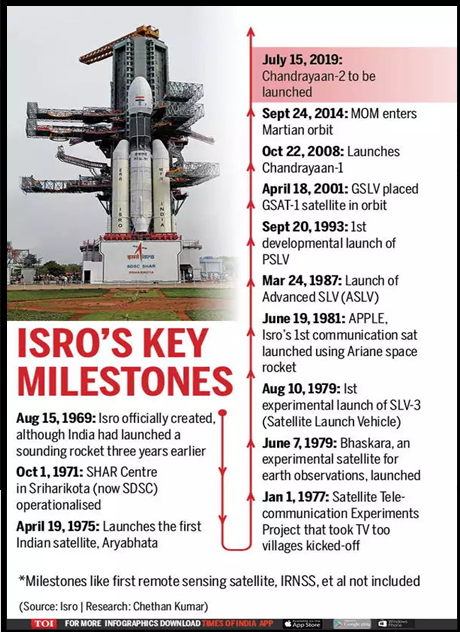MODEST START TO BIG STRIDES: INDIA’S SPACE PROGRAM AT 60
Why in the News?
- On November 21, 1963, India’s space journey commenced with the launch of a 715-kg Nike Apache rocket from Thumba, Thiruvananthapuram.
- This marked the beginning of a transformative odyssey that led India to join an elite group of nations proficient in space exploration.
Source: Times Of India
Milestones in India’s Space Odyssey
- Nike Apache Launch (1963):
- A 715-kg rocket soared 208 km, releasing a sodium vapour payload.
- International collaboration under the United Nations involved contributions from the U.S., France, and the Soviet Union.
- Indigenous Rocket Launch (1969):
- February 22, 1969, witnessed the launch of India’s first truly indigenous rocket, a 10-kg vehicle.
- A significant step towards self-reliance in space exploration.
- Satellite Launch Vehicle 3
(SLV-3) Launch (1980):
- On July 18, 1980, India’s SLV-3 placed the Rohini satellite in orbit.
- India joined a select group with the capability to launch satellites using indigenous vehicles.
Evolution of India’s Space Program
- The SLV-3 paved the way for Augmented Satellite Launch Vehicles (ASLVS), Polar Satellite Vehicles (PSLVs), and Geostationary Satellite Launch Vehicles (GSLVs).
- Despite initial setbacks, ISRO evolved, achieving notable successes.
Recent Achievements (2023)
- July 11, 2023: Launch Vehicle Mark 3 (LVM-3), weighing 640 tonnes, placed Chandrayaan-3’s composite module into earth orbit.
- August 23, 2023: Chandrayaan-3’s lander Vikram successfully landed on the moon, marking a significant milestone.
Significance of LVM-3
- LVM-3, a sophisticated machine, traces its roots back to the Nike Apache launch.
- It enables India to conceive satellites for diverse applications, including
- Remote sensing,
- Weather forecasting,
- Communications, and
- Deep space science missions.
India’s Assured Access to Space
- R. Guruprasad highlights that since 1979, 95 launch vehicles have taken off from Sriharikota.
- ISRO’s achievements include orbiting 90 Indian satellites and deploying 431 satellites from 34 countries, ensuring India’s access to space.
As India continues its exploration of deep space and advances satellite technology, the 60-year legacy stands as a testament to the nation’s prowess in the cosmic realm.





